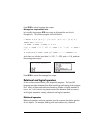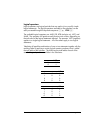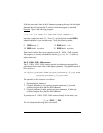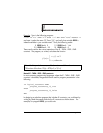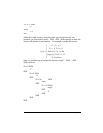
Page 21-44
operators are used to make a statement regarding the relative position of two or
more real numbers. Depending on the actual numbers used, such a statement
can be true (represented by the numerical value of 1. in the calculator), or false
(represented by the numerical value of 0. in the calculator).
The relational operators available for programming the calculator are:
____________________________________________________
Operator Meaning Example
____________________________________________________
ːːʳ “is equal to” ‘x==2’
≠ “is not equal to” ‘3 ≠ 2’
ˏ “is less than” ‘m<n’
> “is greater than” ‘10>a’
≥ “is greater than or equal to” ‘p ≥ q’
≤ “is less than or equal to” ‘7≤12’
_____________________________________________________
All of the operators, except == (which can be created by typing ‚Å
‚Å ), are available in the keyboard. They are also available in „°
@)TEST@.
Two numbers, variables, or algebraics connected by a relational operator form
a logical expression that can take value of true (1.), false (0.), or could simply
not be evaluated. To determine whether a logical statement is true or not,
place the statement in stack level 1, and press EVAL (μ). Examples:
‘2<10’
μ, result: 1. (true)
‘2>10’
μ, result: 0. (false)
In the next example it is assumed that the variable m is not initialized (it has not
been given a numerical value):
‘2==m’
μ, result: ‘2==m’
The fact that the result from evaluating the statement is the same original
statement indicates that the statement cannot be evaluated uniquely.










